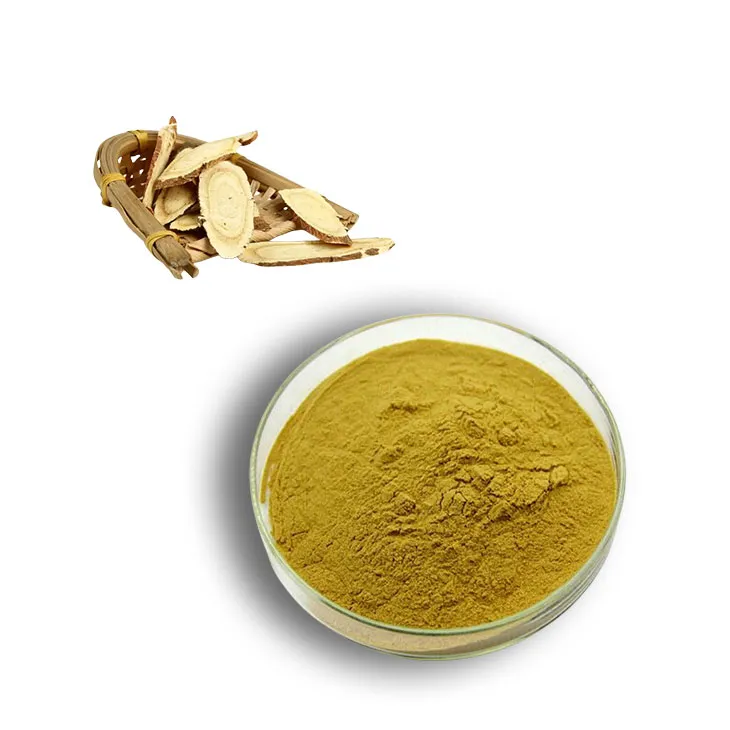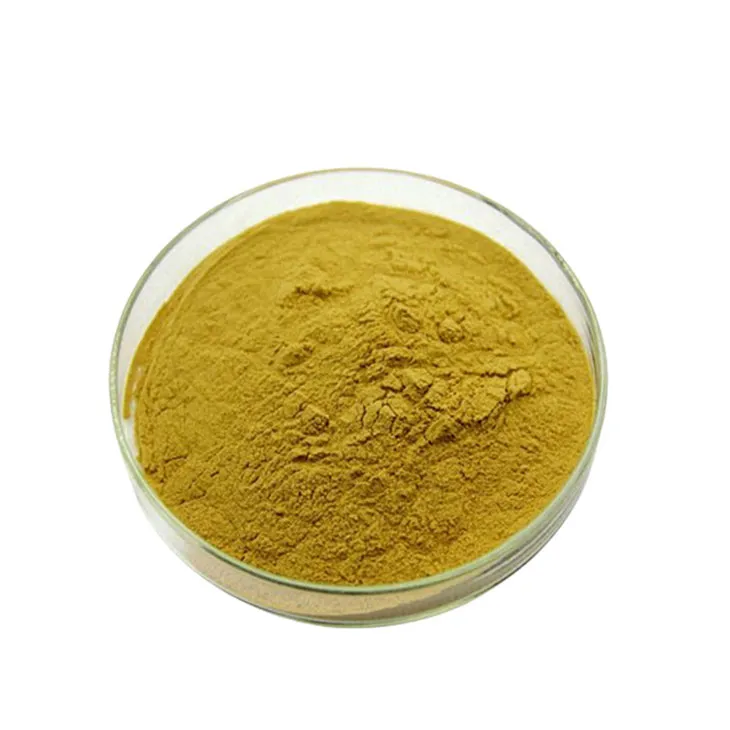- 0086-571-85302990
- sales@greenskybio.com
Understand the main processes of licorice root extract powder manufacturing in the food industry.
2024-12-20

1. Introduction
Licorice Root Extract Powder has become a valuable ingredient in the food industry. It not only imparts a unique taste but also may carry potential functional benefits. Understanding the manufacturing processes of this extract powder is crucial for ensuring its quality and effectiveness in various food applications.

2. Harvesting of Licorice Roots
Harvesting is the first step in the production of Licorice Root Extract Powder. Licorice plants are typically grown in suitable climates and soil conditions. When the plants reach the appropriate maturity level, which is determined based on factors such as plant age, root development, and the desired concentration of active compounds, the roots are ready for harvesting.
Farmers need to carefully dig up the roots to avoid damage. Damage to the roots can lead to a loss of valuable components during the extraction process. In some cases, specialized tools may be used to ensure the integrity of the roots during harvesting.

3. Cleaning of Licorice Roots
Once harvested, the licorice roots must be thoroughly cleaned. This cleaning process serves multiple purposes.
- Removing soil: The roots are often covered with soil particles. Soil can introduce impurities into the extract, affecting its quality and safety for food use. Mechanical cleaning methods, such as brushing or using water jets, are commonly employed to remove the majority of the soil.
- Eliminating other debris: Besides soil, there may be other debris like dead plant parts or small stones attached to the roots. Visual inspection and additional cleaning steps may be required to ensure that all such unwanted materials are removed.
After cleaning, the roots are usually dried briefly to reduce moisture content. This helps in preventing mold growth and prepares the roots for the extraction process.

4. Extraction Process
The extraction process is a crucial step in obtaining the valuable components from licorice roots.
Solvent selection: Different solvents can be used for extraction, depending on the target compounds and the desired properties of the extract. Water is a common solvent as it is safe for use in the food industry. However, organic solvents such as ethanol may also be used, especially when targeting certain hydrophobic compounds. In some cases, a combination of solvents may be employed to optimize the extraction efficiency.
Extraction methods: - Maceration: This is a traditional extraction method. The cleaned and dried licorice roots are soaked in the solvent for an extended period, usually several days to weeks. During this time, the solvent penetrates the root tissues and dissolves the active compounds. Stirring may be applied periodically to enhance the mass transfer of the compounds from the roots to the solvent. - Heat - assisted extraction: As mentioned earlier, in some cases, heat is applied during extraction. Heat can increase the solubility of the compounds and accelerate the extraction process. However, excessive heat can also lead to the degradation of some heat - sensitive compounds. Therefore, the temperature needs to be carefully controlled. For example, a temperature range of 50 - 80°C may be used depending on the nature of the compounds being extracted. - Ultrasonic - assisted extraction: This is a more modern extraction technique. Ultrasonic waves are applied to the solvent - root mixture. The ultrasonic vibrations create cavitation bubbles, which collapse and generate intense local forces. These forces can break the cell walls of the licorice roots more effectively, facilitating the release of the active compounds into the solvent. This method can significantly reduce the extraction time compared to traditional maceration methods.

5. Separation and Purification
After the extraction process, the resulting mixture contains not only the desired licorice root compounds but also other substances such as solvent, cell debris, and unwanted secondary metabolites. Separation and purification processes are carried out to isolate the desired compounds.
Filtration: The first step in separation is often filtration. A filter with an appropriate pore size is used to remove large particles such as cell debris. This can be a simple physical filtration process using filter papers or more advanced membrane filtration systems for better separation efficiency.
Centrifugation: In some cases, centrifugation may be used to further separate the components based on their density differences. The extract is spun at high speeds in a centrifuge, causing the heavier particles to sediment at the bottom while the lighter supernatant, which contains the dissolved licorice root compounds, can be collected.
Chromatography: For more precise purification, chromatography techniques may be employed. For example, high - performance liquid chromatography (HPLC) can be used to separate different compounds based on their chemical properties such as polarity and molecular size. This allows for the isolation of specific active compounds with high purity.
6. Evaporation and Drying
The final step in the production of Licorice Root Extract Powder is the conversion of the liquid extract into powder through evaporation and drying techniques.
Evaporation: The liquid extract is first subjected to evaporation to remove the solvent. This can be done using various methods such as rotary evaporation, where the extract is placed in a rotating flask under reduced pressure. The reduced pressure lowers the boiling point of the solvent, allowing it to be evaporated more easily at a lower temperature. This helps to preserve the integrity of the active compounds in the extract.
Drying: After most of the solvent has been removed through evaporation, the remaining concentrated extract is dried to obtain a powder form. Drying methods include spray drying, freeze - drying, and tray drying. - Spray drying: In spray drying, the concentrated extract is sprayed into a hot air stream. The hot air rapidly evaporates the remaining moisture, converting the liquid droplets into solid powder particles. This method is suitable for large - scale production and can produce fine - grained powders with good flowability. - Freeze - drying: Also known as lyophilization, freeze - drying involves freezing the extract first and then subjecting it to a vacuum environment. The frozen water in the extract sublimes directly from the solid state to the gaseous state, leaving behind a dry powder. Freeze - drying is often used when the active compounds are sensitive to heat, as it can preserve their structure and activity better than other drying methods. - Tray drying: Tray drying is a more traditional drying method. The extract is spread thinly on trays and placed in a drying chamber with controlled temperature and humidity. The drying process is relatively slow compared to spray drying and freeze - drying, but it is a simple and cost - effective method for small - scale production.
7. Quality Control
Throughout the production process of licorice root extract powder, quality control is essential to ensure that the final product meets the required standards for the food industry.
- Raw material inspection: Before starting the production process, the licorice roots are inspected for their quality, including factors such as origin, variety, and absence of contaminants. Only high - quality roots should be used for extraction.
- Process monitoring: During each step of the production process, parameters such as temperature, pressure, extraction time, and solvent concentration are closely monitored. Any deviation from the optimal conditions can affect the quality of the extract powder.
- Final product testing: The final licorice root extract powder is tested for various quality attributes. These include the content of active compounds, purity, microbiological safety, and physical properties such as particle size and solubility. Only products that pass all the tests can be used in the food industry.
8. Conclusion
The production of licorice root extract powder in the food industry involves a series of complex and carefully controlled processes. From the harvesting and cleaning of licorice roots to the extraction, separation, purification, and finally the evaporation and drying to obtain the powder form, each step plays a vital role in ensuring the quality and functionality of the final product. With proper quality control measures in place, licorice root extract powder can be a valuable ingredient in the food industry, offering both unique flavor and potential health - promoting properties.
FAQ:
1. What are the key factors to consider during the harvesting of licorice roots for extract powder production?
The key factors include the maturity of the licorice roots. Harvesting should be done at the appropriate time to ensure the roots contain a sufficient amount of beneficial components. Also, the method of harvesting should be careful not to damage the roots too much, as this could affect the quality of the extract. Additionally, the selection of healthy and high - quality roots is crucial for a good - quality extract powder.
2. How does heat - assisted extraction work in the production of licorice root extract powder?
Heat - assisted extraction involves applying heat during the extraction process. The heat helps to break down the cell walls of the licorice roots more easily, which in turn allows for a more efficient release of the beneficial components. This can increase the yield of the extraction. However, the temperature needs to be carefully controlled to avoid over - heating, which could potentially damage or degrade some of the valuable compounds in the licorice roots.
3. What methods are used for separation and purification in the manufacturing of licorice root extract powder?
Common methods for separation and purification include filtration and chromatography. Filtration can be used to remove solid particles and impurities from the extract. Chromatography, such as high - performance liquid chromatography (HPLC), can be employed to separate and purify specific compounds based on their different chemical properties, ensuring that only the desired components are retained for the final product.
4. Why is the drying process important in the production of licorice root extract powder?
The drying process is important because it converts the liquid extract into a powder form, which is more stable and easier to store and transport. Moreover, proper drying helps to preserve the beneficial components of the licorice root extract. If the drying is not done correctly, for example, if there is residual moisture, it could lead to spoilage or a decrease in the quality and shelf - life of the powder.
5. What are the potential functional benefits of licorice root extract powder in the food industry?
Licorice root extract powder may have several potential functional benefits in the food industry. It can act as a natural sweetener, providing a unique taste. It may also have antioxidant properties, which can help in preventing the oxidation of food components. Additionally, it has been associated with potential anti - inflammatory effects, which could be beneficial in certain food products.
Related literature
- Production and Application of Licorice Root Extract in the Food Industry"
- "Optimization of Licorice Root Extract Powder Manufacturing Processes"
- "The Role of Licorice Root Extract in Food: A Comprehensive Review"
- ▶ Hesperidin
- ▶ Citrus Bioflavonoids
- ▶ Plant Extract
- ▶ lycopene
- ▶ Diosmin
- ▶ Grape seed extract
- ▶ Sea buckthorn Juice Powder
- ▶ Fruit Juice Powder
- ▶ Hops Extract
- ▶ Artichoke Extract
- ▶ Mushroom extract
- ▶ Astaxanthin
- ▶ Green Tea Extract
- ▶ Curcumin
- ▶ Horse Chestnut Extract
- ▶ Other Product
- ▶ Boswellia Serrata Extract
- ▶ Resveratrol
- ▶ Marigold Extract
- ▶ Grape Leaf Extract
- ▶ New Product
- ▶ Aminolevulinic acid
- ▶ Cranberry Extract
- ▶ Red Yeast Rice
- ▶ Red Wine Extract
-
Oat Straw Extract Powder
2024-12-20
-
Scutellaria Extract
2024-12-20
-
Plantain extract
2024-12-20
-
Avocado Extract Powder
2024-12-20
-
Mangosteen extract powder
2024-12-20
-
White Peony Extract
2024-12-20
-
Dandelion Leaf Extract
2024-12-20
-
Echinacea Extract
2024-12-20
-
Maitake Mushroom Extract
2024-12-20
-
Yohimbine Bark Extract
2024-12-20





















